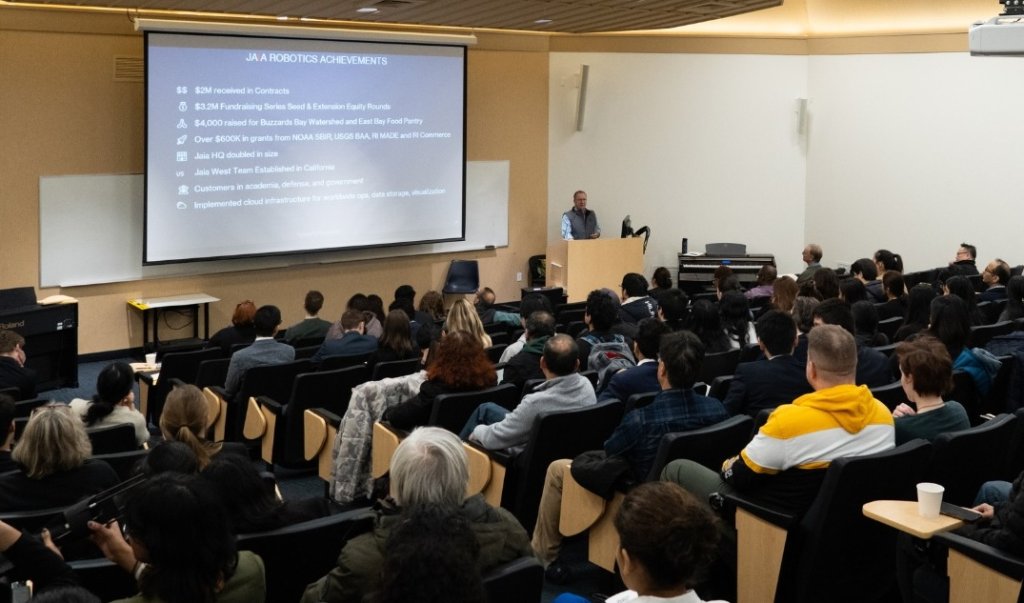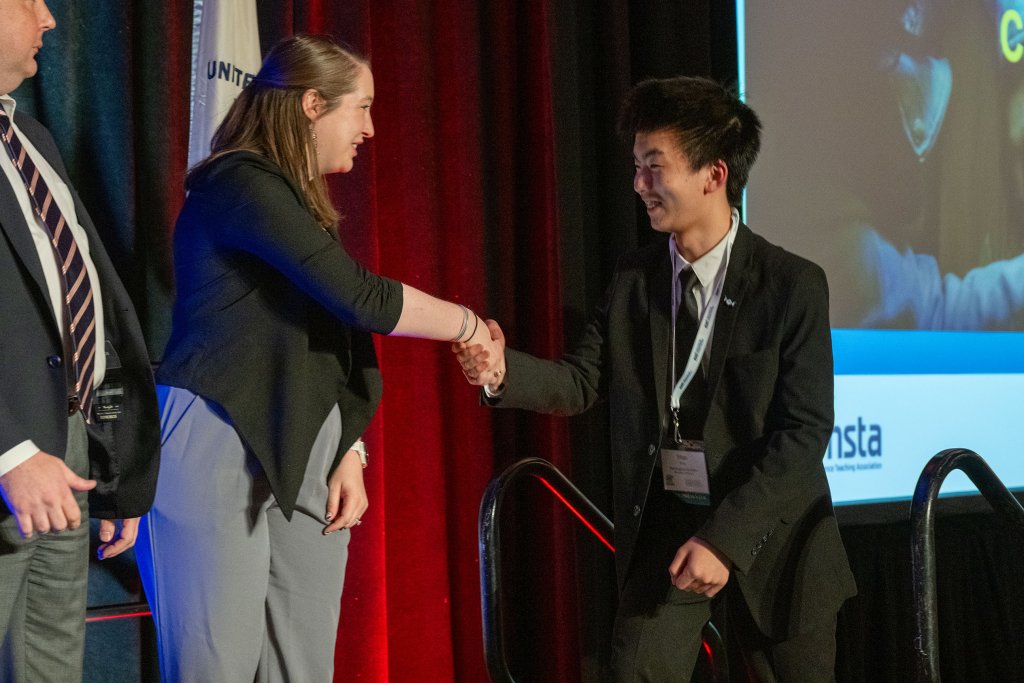NES JSHS: Past Events
Each year RWU welcomes the next generation of STEM professionals. Here are some highlights from past events.
2024 JSHS Highlights

In 2024, we welcomed over 70 high school students to campus to share their research. The keynote speaker was Ian Estaphan Owen, Co-Founder and CEO of Jaia Robotics. The Naval Undersea Warfare Center also demonstrated its advanced robotics capabilities.

Top 5 projects

Wherever humans have traveled throughout history, diseases have always seemed to follow. Luckily, humans have developed a robust defense mechanism known as the immune system, where antibodies are a key player. For antibodies to be effective, they must bind to the surfaces of disease-related antigens with highly variable shapes, doing so through recombination processes that make each antibody unique. This uniqueness allows for a correlation to be established from an antibody to its corresponding disease. While there have been previous attempts to correlate diseases using feature-based machine learning, the direct use of amino acid sequences in a deep learning model remains to be explored. Here, we propose a language modeling-based approach for classifying disease-specific antibodies against a healthy control set. Using the pre-trained ProtBERT-BFD model from Rostlab, we were able to generate an embedding vector with 1024 values for each amino acid in an antibody sequence. These values were then averaged across every amino acid to obtain a single “sentence-embedding vector” that was passed to a feedforward neural network of progressively smaller layers. The final output consisted of probability matches for each disease, with the highest probability becoming the predicted class. This multi-class model was then implemented in antibodies associated with COVID-19, HIV, influenza, Dengue fever, CLL, and a healthy control, achieving an overall accuracy of 90.50%. We believe this high accuracy demonstrates the potential for a rapid, multi-disease diagnosis method supporting hundreds of diseases, carrying with it immense ramifications for the future of medical testing.
Joseph also won first place in the Medicine and Health category at JSHS Nationals.

Gene switches that can artificially regulate gene expression are in high demand for developing safe and effective gene therapies. Using in vitro cell culture, DNA transfection, and fluorescence microscopy, I first examined efficiencies of the three stop codons in terminating protein translation. Interestingly, I found that all three stop codons were “leaky” albeit at low levels and could be subject to termination readthrough. I identified the stop codon UGA (or TGA in DNA), when flanked with six virus-derived downstream nucleotides, was particularly amenable to chemical modulation in its readthrough propensity. Based on these findings, I constructed a new two-component gene switch that consisted of a nine-nucleotide, TGA-comprised DNA effector and a chemical inducer. The DNA effector was designed to be inserted into the target gene of interest and to limit gene expression using the native function of the stop codon TGA. The chemical inducer, such as the clinically available gentamicin, would be applied separately to increase readthrough of TGA thereby “switching on” target gene expression. I validated the design of such gene switch by observing its function in controlling Cre recombination in vitro. Importantly, I further demonstrated feasibility of using this gene switch to engineer “switchable” CRISPR-Cas9 gene editing machinery that could have potential for clinical use. The extremely small size of the DNA effector, low risk of immunogenicity, and clinical track record of the chemical inducer make the gene switch I reported herein a potentially versatile tool for developing inducible cell and gene therapies.
Evan also won third place in the Biomedical Sciences category at JSHS nationals.
HD189733b and HD209457 are both canonical exoplanets with deep transits,short periods and bright host stars, allowing us to determine a precise and accurate radius and temperature. We used EXOFASTv2 to run a series of stellar fits and were able to infer HD189733b’s radius to 1.1% (0.7585+0.0088 R ) and its temperature −0.0086 to 1.2% (5141+61 K) - a factor of 2 improvement in precision over previous studies. Our stellar radius is 2.6 sigma discrepant from its CHARA-measured interferometric value (0.805+0.016 R ) which, we argue, are due to systematic errors in the interferometric radius. HD189733’s angular size is only 1.1 mas, and interferometric radius measurements have shown significant disagreements when the angular diameter is below 1.25 mas. Thus, this suggests that the widely accepted stellar parameters are significantly overestimated and less precise than our conclusions. For HD209458, we were able to measure the radius to 1.44% (1.196+0.019 R ) and its temperature to −0.020 1.7% (6110+110 K) - a factor of 2.4 improvement in precision over alternative studies. While HD209458 does not have an available interferometric radius, we determined that our values have a higher level of precision than traditional methods that rely on spectroscopy and theoretical modeling. In this paper, we generalize our procedure so we can accurately and precisely determine the radii and temperatures of stars with high signal to noise transiting planets while carefully accounting for systematic errors.
The precise and accurate leukemia detection in current clinical practice still remains challenging due to limitations in cost, time, and medical experience. To address this issue, this research aims to develop the first integrated low-cost automatic artificial intelligence system for the real-time localization and classification of acute myeloid leukemia in bone marrow smears, named ALLocate. This system consists of an automatic microscope stage, an image sampling system, and a deep learning-based localization and classification system. A region classifier using a convolutional neural network (CNN) model was developed to select usable regions from unusable blood and clot regions with an accuracy of 96%. To achieve cell segmentation, a U-net-based model was established with an accuracy of 85% in usable marrow regions. For real-time detection, the YOLOv8 model was developed and optimized. The key variables for optimization include the number of epochs, learning rate, and network architecture. These models show high performance with a region classifier accuracy of 96%, U-net accuracy of 85%, and YOLOv8 mAP of 91%. In addition, a low-cost automatic microscope stage and scanner system was developed using 3D-printed pieces controlled by stepper motors and a programmed RAMPS control board. This is the first report to integrate the deep learning system with a low-cost microscope automatic stage and scanner system for leukemia detection. For small community practices or clinics in rural areas or developing countries,the developed ALLocate can significantly improve the efficiency of leukemia detection from the aspirate smears in a real clinical setting.
As we enter an era where natural disasters are increasing in frequency and intensity globally, the need for advanced disaster response technologies has never been more pressing. Floods, in particular, pose a formidable threat to communities and infrastructure worldwide, demanding effective and comprehensive response systems.
Remote sensing plays a crucial role in disaster response, and has become an indispensable tool for scientists and decision makers alike (Frackiewicz, 2023). Synthetic Aperture Radar (SAR), an effective and rapidly developing technique, has traditionally been mounted on satellites and airplanes to create wide-spanning images of the planet (IEEE, 2019). However, despite the added flexibility, resolution, and potential for detailed disaster tracking, unmanned aerial vehicle (UAV)-based SAR approaches have been largely unnoticed.
Our system aims to pioneer new approaches to SAR-based remote sensing by creating a high-quality and low-computational-cost UAV-based SAR visualization system. Our software, programmed from scratch and fully based in Python, showcases effective approaches to SAR visualization with features that encourage its application in flood disaster response. In this paper, we detail the development of the SAR visualization system and our findings on the most effective approaches.